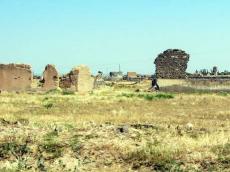|
|
TODAY.AZ / Politics
22 years pass since Agdere occupation
07 July 2015 [14:28] - TODAY.AZ

By Sara Rajabova
July 7 marks the occupation of Azerbaijan’s Agdere region, located to the north of Nagorno-Karabakh, by Armenian armed forces in 1993.
Like the other provinces in Azerbaijan’s Nagorno-Karabakh region, Agdere region was captured by the Armenian armed forces during the beginning of the Karabakh war.
Agdere city was liberated from the Armenian invaders on July 4, 1992 in an attack by the Azerbaijani army. For a year, intensive fighting ensued in nearby villages surrounding Agdere.
In addition, the political situation in Azerbaijan was very unstable in those times. Given this opportunity, the Armenian army re-occupied Agdere on July 7, 1993.
Currently, several villages of the region are under Azerbaijan’s control, but much of the province, including Agdere city, has been under Armenian occupation for over 20 years.
The Agdere region was formed during Soviet rule in 1930. It was referred to as Jerabert until 1939 when its name was changed to Mardakert, lasting until 1991. In 1991, the name of the region was restored. In October 1992 the Azerbaijani government divided the region of Agdere among three regions outside of Karabakh—Tartar, Aghdam, and Kalbajar.
Agdere region had the highest concentration of ethnic Azerbaijanis in Nagorno-Karabakh, after Shusha. Before the occupation, more than 14,000 Azerbaijanis had been living in the 14 villages of the region.
The region was an important agricultural region in Karabakh. The economy was dominated by the viticulture, grain cropping, tobacco, and cattle-breeding.
Agdere is rich with natural recourses and minerals. The Mehmana polymetallic deposit in the region contains limestone and plaster. Coal deposits were discovered in the late 1980s within the territorial boundary of Agdere.
Like the other parts of the Nagorno-Karabakh, Agdere was also rich with historical monuments.
Among the well-known architectural monuments of the region are the Ganjasar Albanian temple in the village of Vangli, Holy Iako temple in the village of Kolatag (of 635), Urek temple (XII century) near the village of Talysh, the temple at upper flow of the river Tartar (XIII century), Hatem Malik Tower, along with many other ancient temples and bridges.
Unfortunately, all of these were destroyed by the Armenian occupants after the invasion of the region.
Armenia and Azerbaijan fought a lengthy war that ended after signing of a precarious ceasefire in 1994. Since then, Armenian armed forces have occupied over 20 percent of Azerbaijan's internationally recognized territory, including Nagorno-Karabakh, defying international calls and UN resolutions.
Peace talks, mediated by Russia, France and the U.S. through the OSCE Minsk Group, are underway on the basis of a peace outline proposed by the Minsk Group co-chairs and dubbed the Madrid Principles. The negotiations have been largely fruitless so far.
URL: http://www.today.az/news/politics/142041.html
 Print version
Print version
Connect with us. Get latest news and updates.
See Also
- 30 August 2025 [16:19]
Azerbaijani families of missing persons hold protest in Geneva - 30 August 2025 [16:18]
President of Azerbaijan Ilham Aliyev arrives in China for a working visit - 30 August 2025 [14:46]
First resettlement to Aghdam to begin this autumn - 30 August 2025 [11:49]
Azerbaijan is important member of SCO family, says Ambassador Lu Mei - 29 August 2025 [14:39]
Fidan praises Azerbaijan-Armenia agreements and emphasizes trust on Zangazur Corridor - 29 August 2025 [14:00]
Armenian revanchists remembered about international law! - 29 August 2025 [12:46]
Russia welcomes Azerbaijan-Armenia decision to dissolve OSCE Minsk Group - 29 August 2025 [10:50]
Evidence presented in Baku trial shows direct Armenian military aggression - 29 August 2025 [10:21]
Azerbaijan, Uganda explore new horizons in agricultural cooperation - 28 August 2025 [14:34]
Azerbaijan joins CIS Deputy Prosecutors General meeting in Moscow
Most Popular
 Baku has put all the dots above the "I" in the issue of the Zangezur corridor
Baku has put all the dots above the "I" in the issue of the Zangezur corridor
 Youth Camp of CIS Countries wraps up in Lachin
Youth Camp of CIS Countries wraps up in Lachin
 Azerbaijan, Argentina discuss expansion of economic cooperation
Azerbaijan, Argentina discuss expansion of economic cooperation
 Azerbaijan joins CIS Deputy Prosecutors General meeting in Moscow
Azerbaijan joins CIS Deputy Prosecutors General meeting in Moscow
 Azerbaijan, EIB discuss prospects for stronger partnership
Azerbaijan, EIB discuss prospects for stronger partnership
 President Ilham Aliyev receives EU Special Representative for South Caucasus
President Ilham Aliyev receives EU Special Representative for South Caucasus
 Azerbaijan, Venezuela reaffirm commitment to expand bilateral cooperation
Azerbaijan, Venezuela reaffirm commitment to expand bilateral cooperation
